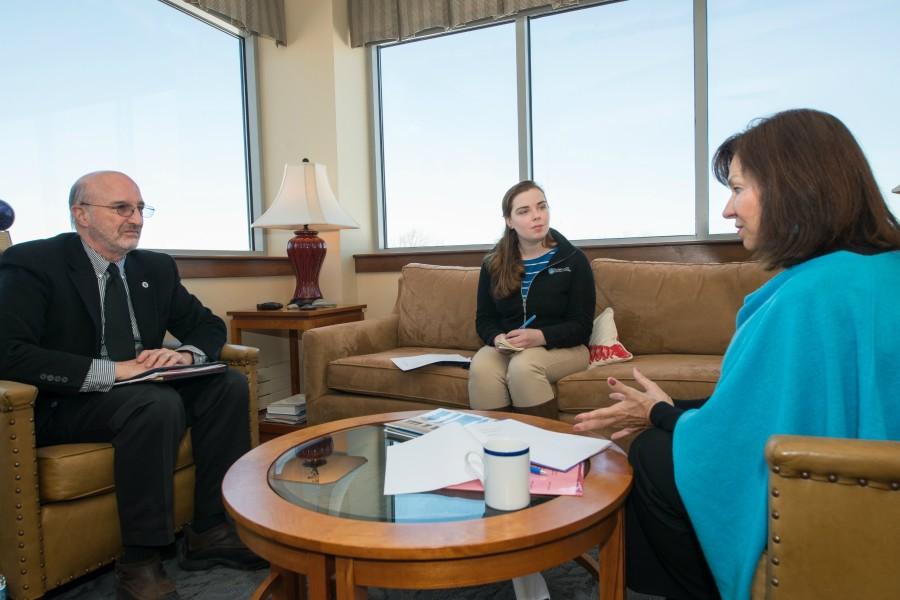A Day with the President
President Ripich, Bill Bola and Shannon Cardinal. Photo Credit: Holly Haywood
April 26, 2015
rIt’s 10 a.m. and President Danielle Ripich walks out of her office from a morning meeting, looking for a different jacket so as to avoid a fashion faux-pas.
Her orange overcoat and scarf combo looks becoming against her chestnut hair, but she’s already taken pictures for the American Heart Association in that outfit, and they have returned to award President Ripich with a Crystal Heart. Wary of committing outfit repetition for the same institution’s pictures, a sin as objectionable to public figures like Ripich as it is to Regina George, she changes into a UNE blue, wrap around shawl and finishes her meeting after posing for the camera. Then she emerges to warmly greet the UNE press cadre, Nate Towne, Dan Lambert, Holly Haywood and myself, ready to document a day in the life of this institution’s venerable leader.
Ripich invites me into her office, and I immediately note the pictures- John F. Kennedy, James Joyce and Edna St. Vincent Millay line the back wall by her desk, and a picture of her family sits on the bookshelf by the door. The room is comfortable, with a beautiful view of the Saco River and the softball field.
The voices in her day are dizzying. Meetings fill most of her time, and many advisors update her on UNE’s expansions and issues as they arise, helping her to plan and address the changing needs of the community. I sit in as she discusses the upcoming Master Plan with William “Bill” Bola, Vice President for Operations. A tall, thin man with round spectacles and a great deal of excitement as he discusses future plans, he manages the building and maintenance of UNE facilities, and his goal is “increasing programming and usage.”
Over coffee set on the round, glass table surrounded by a comfy couch and two brown armchairs, Bola and Ripich discuss a list of potential projects, including the addition of a Beach-in-a-Box on the River Lot near the marsh area of Jordan Point, and the acquisition of Ram Island. Some of the projects are vague, like “Improve Food Service.” Some are concrete and the plans are already in the works, like tennis courts by the Alford Forum. They celebrate the success of a $150,000 grant to improve the efficiency of UNE facilities. UNE updated much of the lighting and many other services, and saw incredible savings as they actively worked to shrink UNE’s footprint, electricity bill, and “live lightly on the land,” a term Ripich uses often and takes seriously. There are of course setbacks and problems, and part of their confusion lies in trying to meet student needs and demands when “students change so much, so fast.”
Her next meeting is with John Tumiel, Senior Advisor to the President and Chief Compliance Officer. A commanding presence with intelligent blue eyes and a very professional demeanor, he is Ripich’s right hand man, and very wary of the presence of the student press. Much of what he has to say is prefaced by “this is off-the-record.” On the record, he discusses personnel, the possible addition of Men’s Rugby, and the triumphs and struggles of the new cheer squad. They discuss many of the sports teams, which is an appropriate segue for her lunch with some of UNE’s athletic student leaders.
Vice President Jim Koebl and six students sit around the table and introduce themselves. Cam represents track and field, Lauren basketball, Kelly softball, Taylor soccer, Mary hockey, and Grayson volleyball. They are invited to share their ideas with the President, who opens the lunch time discussion by asking for their honest opinions about UNE, joking that she knows it may be shocking “but sometimes when you’re in a leadership position, people tell you what they think you want to hear and not necessarily the truth.” The students appreciate her candor, and respond in kind, asking for a Certified Strength and Coordination Specialist for the athletic support staff. They discuss UNE policies like mandatory study hours for student athletes at the library, which most seemed in favor of. In talking about retention and diversity rates, Ripich comments “I mean, it’s Maine. We do what we can.”
After lunch and between meetings, she’s very candid about her work, admitting that sometimes she feels as if all her meetings are getting in the way of doing her job, but then an inner voice reminds her “that is your work!” She professes a sunny outlook on leadership, saying “in these roles you learn you can lose the battle, and end up winning the war.”



